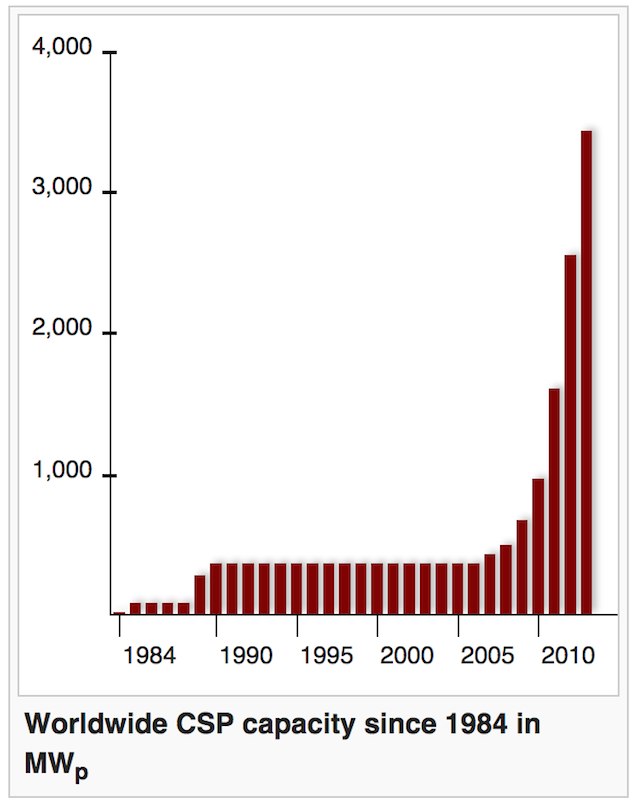forum
library
tutorial
contact

Why You Should Be Paying Attention
to the 'Other' Form of Solar Power
by Joe Romm
Climate Progress, June 10, 2015
|
the film forum library tutorial contact |

|
Why You Should Be Paying Attention
by Joe Romm
|
Solar photovoltaic (PV) systems have seen explosive growth because of
their stunning 99 percent price drop in the past quarter century.
Solar photovoltaic (PV) systems have seen explosive growth because of their stunning 99 percent price drop in the past quarter century. As a result, the other form of solar power -- concentrating solar thermal power (CSP) -- is a small fraction of the solar market.
But the International Energy Agency (IEA) says CSP has a very bright future too because it enables cheap, efficient storage, which allows CSP plants to provide electricity long after the sun has set. According to the IEA's 2014 CSP Technology Roadmap, 11 percent of global electricity will be generated by concentrating solar thermal power in 2050. In this post, I review the basics of CSP and look at how its recent resurgence portends a big future.
Parabolic TroughCSP is the use of mirrors to focus sunlight to heat a fluid that runs an engine to make electricity. One of the basic CSP designs used today is the power tower (above photo of the Crescent Dunes Solar Energy Project), which uses many mirrors moving in two dimensions to focus sunlight on a central tower that holds the engine. Another key design is the parabolic trough, which uses mirrors to focus the light on a long tube filled with a heat-storing fluid (right).
The key attribute of CSP is that it generates primary energy in the form of heat, which can be stored 20 to 100 times more cheaply than electricity -- and with far greater efficiency. Commercial projects have already demonstrated that CSP systems can store energy by heating oil or molten salt, which can retain the heat for hours.
Here is a basic overview video of CSP from the U.S. Department of Energy.
What is happening right now with CSP? While market penetration has been slower than expected, in part because of the stunning price drop in PV power, CSP has begun to see significant growth.
 Here is a chart of global CSP capacity from 1984 through 2013 in Megawatts:
Here is a chart of global CSP capacity from 1984 through 2013 in Megawatts:
A 2014 independent market analysis projected that the global CSP market will see "phenomenal growth at a 19.4% CAGR [compound annual growth rate] between 2014 and 2020." A global CSP market that was worth $2.5 billion in 2013 would hit nearly $8.7 billion by the end of 2020.
Both the U.S. National Renewable Energy Lab and the IEA have said that after solar PV makes a deep penetration into the electricity market, CSP will likely become more valuable. A 2014 NREL study found a CSP project with thermal storage "would add additional value of 5 or 6 cents per kilowatt hour to utility-scale solar energy in California where 33 percent renewables will be mandated in six years."
The more other forms of renewable power, especially PV, penetrate the market, the more valuable CSP becomes. Why? Right now, solar PV generates electricity at the most valuable time -- daily peak electricity usage in daytime, particularly during the summertime, when air conditioning becomes the big draw on electric power.
But once solar PV hits 10 percent to 15 percent of annual electric generation in a region, PV can become less valuable. The IEA projects that when that occurs, perhaps around 2030, "Massive-scale [solar thermal electric] deployment takes off at this stage thanks to CSP plants' built-in thermal storage, which allows for generation of electricity when demand peaks in late afternoon and in the evening, thus complementing PV generation."
A 2014 study in Nature Climate Change from Austria's International Institute for Applied Systems Analysis found that in Mediterranean region, "a connected CSP system could provide 70-80% of current electricity demand, at no extra cost compared to gas-fired power plants." In the new study led by Stanford Professor Mark Jacobson, "100% clean and renewable wind, water, and sunlight (WWS) all-sector energy roadmaps for the 50 United States," some 7.3 percent of total end-use power is generated by CSP with storage -- with additional CSP used "for peaking and grid stability."
The IEA's 2014 roadmaps show that with the right policies and continued technology improvement, PV could provide as much as 16 percent of the world's electricity by 2050 while 11 percent could be provided by CSP plants, which the IEA calls Solar Thermal Electric (STE). IEA Solar 2050
In that scenario, "Combined, these solar technologies could prevent the emission of more than 6 billion tonnes of carbon dioxide per year by 2050 -- that is more than all current energy-related CO2 emissions from the United States or almost all of the direct emissions from the transport sector worldwide today."
One final note: What could dim the bright future of CSP in a carbon-constrained world? If electricity storage became considerably cheaper. If, say, battery technology makes major advances or if electric vehicles continue their recent exponential growth and widespread vehicle-to-grid systems become widespread. May the best technology win!
learn more on topics covered in the film
see the video
read the script
learn the songs
discussion forum
